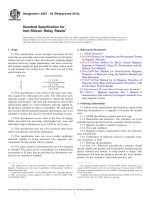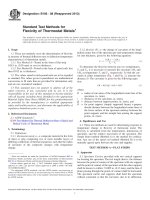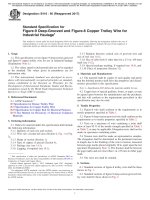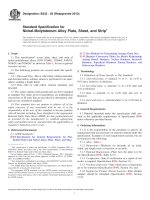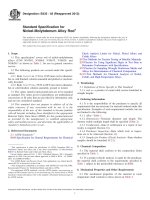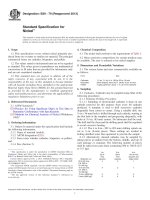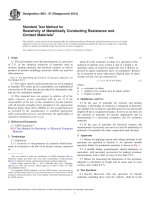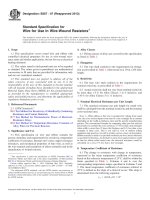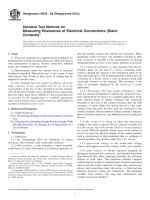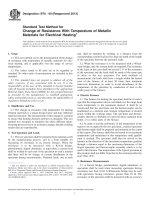Astm b 867 95 (2013)
Bạn đang xem bản rút gọn của tài liệu. Xem và tải ngay bản đầy đủ của tài liệu tại đây (158.74 KB, 10 trang )
Designation: B867 − 95 (Reapproved 2013)
Standard Specification for
Electrodeposited Coatings of Palladium-Nickel for
Engineering Use1
This standard is issued under the fixed designation B867; the number immediately following the designation indicates the year of
original adoption or, in the case of revision, the year of last revision. A number in parentheses indicates the year of last reapproval. A
superscript epsilon (´) indicates an editorial change since the last revision or reapproval.
1. Scope
2. Referenced Documents
2.1 ASTM Standards:3
B183 Practice for Preparation of Low-Carbon Steel for
Electroplating
B242 Guide for Preparation of High-Carbon Steel for Electroplating
B254 Practice for Preparation of and Electroplating on
Stainless Steel
B281 Practice for Preparation of Copper and Copper-Base
Alloys for Electroplating and Conversion Coatings
B322 Guide for Cleaning Metals Prior to Electroplating
B343 Practice for Preparation of Nickel for Electroplating
with Nickel
B374 Terminology Relating to Electroplating
B481 Practice for Preparation of Titanium and Titanium
Alloys for Electroplating
B482 Practice for Preparation of Tungsten and Tungsten
Alloys for Electroplating
B487 Test Method for Measurement of Metal and Oxide
Coating Thickness by Microscopical Examination of
Cross Section
B488 Specification for Electrodeposited Coatings of Gold
for Engineering Uses
B489 Practice for Bend Test for Ductility of Electrodeposited and Autocatalytically Deposited Metal Coatings on
Metals
B507 Practice for Design of Articles to Be Electroplated on
Racks
B542 Terminology Relating to Electrical Contacts and Their
Use
B558 Practice for Preparation of Nickel Alloys for Electroplating
B568 Test Method for Measurement of Coating Thickness
by X-Ray Spectrometry
B571 Practice for Qualitative Adhesion Testing of Metallic
Coatings
B602 Test Method for Attribute Sampling of Metallic and
Inorganic Coatings
1.1 Composition—This specification covers requirements
for electrodeposited palladium-nickel coatings containing between 70 and 95 mass % of palladium metal. Composite
coatings consisting of palladium-nickel and a thin gold overplate for applications involving electrical contacts are also
covered.
1.2 Properties—Palladium is the lightest and least noble of
the platinum group metals. Palladium-nickel is a solid solution
alloy of palladium and nickel. Electroplated palladium-nickel
alloys have a density between 10 and 11.5, which is substantially less than electroplated gold (17.0 to 19.3) and comparable to electroplated pure palladium (10.5 to 11.8). This yields
a greater volume or thickness of coating per unit mass and,
consequently, some saving of metal weight. The hardness
range of electrodeposited palladium-nickel compares favorably
with electroplated noble metals and their alloys (1, 2).2
NOTE 1—Electroplated deposits generally have a lower density than
their wrought metal counterparts.
Approximate Hardness (HK25)
Gold
Palladium
Platinum
Palladium-Nickel
Rhodium
Ruthenium
50–250
75–600
150–550
300–650
750–1100
600–1300
1.3 The values stated in SI units are to be regarded as the
standard. The values given in parentheses are for information
only.
1.4 This standard does not purport to address all of the
safety concerns, if any, associated with its use. It is the
responsibility of the user of this standard to establish appropriate safety and health practices and determine the applicability of regulatory limitations prior to use.
1
This specification is under the jurisdiction of ASTM Committee B08 on
Metallic and Inorganic Coatings and is under the direct responsibility of Subcommittee B08.03 on Engineering Coatings.
Current edition approved Dec. 1, 2013. Published December 2013. Originally
approved in 1995. Last previous edition approved in 2008 as B867 – 95 (2008).
DOI: 10.1520/B0867-95R13.
2
The boldface numbers in parentheses refer to the list of references at the end of
this specification.
3
For referenced ASTM standards, visit the ASTM website, www.astm.org, or
contact ASTM Customer Service at For Annual Book of ASTM
Standards volume information, refer to the standard’s Document Summary page on
the ASTM website.
Copyright © ASTM International, 100 Barr Harbor Drive, PO Box C700, West Conshohocken, PA 19428-2959. United States
1
B867 − 95 (2013)
TABLE 1 Composition Type
B697 Guide for Selection of Sampling Plans for Inspection
of Electrodeposited Metallic and Inorganic Coatings
B741 Test Method for Porosity In Gold Coatings On Metal
Substrates By Paper Electrography (Withdrawn 2005)4
B748 Test Method for Measurement of Thickness of Metallic Coatings by Measurement of Cross Section with a
Scanning Electron Microscope
B762 Test Method of Variables Sampling of Metallic and
Inorganic Coatings
B765 Guide for Selection of Porosity and Gross Defect Tests
for Electrodeposits and Related Metallic Coatings
B798 Test Method for Porosity in Gold or Palladium Coatings on Metal Substrates by Gel-Bulk Electrography
B799 Test Method for Porosity in Gold and Palladium
Coatings by Sulfurous Acid/Sulfur-Dioxide Vapor
B809 Test Method for Porosity in Metallic Coatings by
Humid Sulfur Vapor (“Flowers-of-Sulfur”)
B827 Practice for Conducting Mixed Flowing Gas (MFG)
Environmental Tests
B845 Guide for Mixed Flowing Gas (MFG) Tests for Electrical Contacts
B849 Specification for Pre-Treatments of Iron or Steel for
Reducing Risk of Hydrogen Embrittlement
B850 Guide for Post-Coating Treatments of Steel for Reducing the Risk of Hydrogen Embrittlement
D1125 Test Methods for Electrical Conductivity and Resistivity of Water
D3951 Practice for Commercial Packaging
Type
Nominal Composition (Mass %)
I
II
III
IV
75 %
80 %
85 %
90 %
Pd/25 %
Pd/20 %
Pd/15 %
Pd/10 %
Range (Mass% Pd)
Ni
Ni
Ni
Ni
70–80 %
75–85 %
80–90 %
85–95 %
Pd
Pd
Pd
Pd
TABLE 2 Thickness ClassA
A
Thickness Class
Minimum Thickness of Pd-Ni (µm)
0.4
0.5
0.7
1.0
1.3
1.5
2.0
2.5
3.0
0.4
0.5
0.7
1.0
1.3
1.5
2.0
2.5
3.0
See Appendix X3 on Electrical Contact Performance Versus Thickness Class.
TABLE 3 Gold OverplateA
Grade
0
1
2
A
Type
No Overplate
1 (99.9 % Au min)
2 (99.7 % Au min)
MIL-G45204
...
III
I
Hardness (Code)
...
90 HK25 max (A)
130–200 HK25 (C)
Thickness
Range
...
0.05–0.12 µm
0.05–0.25 µm
See Specification B488 and Appendix X1 and Appendix X2.
5. Ordering Information
3. Terminology
5.1 In order to make the application of this specification
complete, the purchaser shall supply the following information
to the seller in the purchase order or other governing document:
5.1.1 The name, designation, and date of issue of this
specification;
5.1.2 The coating system including basis metal, composition type, thickness class and gold overplate grade (see 4.1 and
Table 1, Table 2, and Table 3);
5.1.3 Presence, composition, and thickness of underplating
(see 3.2.1). For nickel underplating see 6.5.1;
5.1.4 Significant surfaces shall be defined (see 3.2.3);
5.1.5 Requirements, if any, for porosity testing (see 9.6);
5.1.6 (Steel parts only) Stress relief if required (see Specification B849);
5.1.7 (Steel parts only) Hydrogen embrittlement relief (see
B850 );
5.1.8 Sampling plan employed (see Section 8); and,
5.1.9 Requirement, if any, for surface coating cleanliness
(absence of residual salts). See Appendix X6.
3.1 Definitions: Many terms used in this specification are
defined in Terminology B374 or B542.
3.2 Definitions of Terms Specific to This Standard:
3.2.1 overplating, n—a coating applied onto the topmost
palladium-nickel coating. The thickness of an overplating or
“flash” is usually less than 0.25 µm.
3.2.2 significant surfaces, n—those surfaces normally visible (directly or by reflection) or which are essential to the
serviceability or function of the article; or which can be the
source of corrosion products or tarnish films that interfere with
the function or desirable appearance of the article. The significant surfaces shall be indicated on the drawings of the parts, or
by the provision of suitably marked samples.
3.2.3 underplating, n—a metallic coating layer or layers
between the basis metal or substrate and the palladium-nickel
coating. The thickness of an underplating is usually greater
than 1 µm, in contrast to a strike which is thinner.
4. Classification
6. Manufacture
4.1 Orders for articles to be plated in accordance with this
specification shall specify the coating system, indicating the
basis metal, the thicknesses of the underplatings, the type and
thickness class of the palladium-nickel coating, and the grade
of the gold overplating according to Table 1, Table 2, and Table
3. See Section 7.
6.1 Any process that provides an electrodeposit capable of
meeting the specified requirements will be acceptable.
6.2 Substrate:
6.2.1 The surface condition of the basis metal should be
specified and should meet this specification prior to the plating
of the parts.
6.2.2 Defects in the surface of the basis metal, such as
scratches, porosity, pits, inclusions, roll and die marks, laps,
4
The last approved version of this historical standard is referenced on
www.astm.org.
2
B867 − 95 (2013)
cracks, burrs, cold shuts, and roughness may adversely affect
the appearance and performance of the deposit, despite the
observance of the best plating practice. Any such defects on
significant surfaces should be brought to the attention of the
supplier and the purchaser.
6.2.3 Clean the basis metal as necessary to ensure a satisfactory surface for subsequent electroplating in accordance
with Practices B183, B242, B254, B281, B322, B343, B481,
B482, and B558.
6.2.4 Proper preparatory procedures and thorough cleaning
of the basis metal are essential for satisfactory adhesion and
performance of these coatings. The surface must be chemically
clean and continuously conductive, that is, without inclusions
or other contaminants. The coatings must be smooth and as free
of scratches, gouges, nicks, and similar imperfections as
possible.
6.5.4 Gold Overplating—Apply a thin gold overplating after
the palladium-nickel in any application in which palladiumnickel plated electrical connectors are mated together in a
contact pair. This process is necessary to preserve the performance of the contact surface. See Appendix X1 for other
reasons for using a gold overplate.
NOTE 6—When using Type 1 gold, the thickness of the gold overplate
shall not exceed 0.12 µm (5 µin.) due to increased risk of degrading
durability and increasing the coefficient of friction.
6.5.5 Residual Salts—For rack and barrel plating
applications, residual plating salts can be removed from the
articles by a clean, hot (50 to 100°C) water rinse. A minimum
rinse time of 2.5 min (racks) or 5 min (barrel) is suggested.
Best practice calls for a minimum of three dragout rinses and
one running rinse with dwell times of 40 s in each station when
rack plating and 80 s when barrel plating. Modern highvelocity impingement type rinses can reduce this time to a few
seconds. This is particularly useful in automatic reel-to-reel
applications where dwell times are significantly reduced. See
Appendix X6.
NOTE 2—A metal finisher can often remove defects through special
treatments such as grinding, polishing, abrasive blasting, chemical
treatments, and electropolishing. However, these may not be normal in the
treatment steps preceding the plating, and a special agreement is indicated.
6.3 If required (see 5.1.6), steel parts with a hardness greater
than 1000 MPa (31 HRC) shall be given a suitable stress relief
heat treatment prior to plating in accordance with Specification
B849. Such stress relief shall not reduce the hardness to a value
below the specified minimum. Avoid acid pickling of high
strength steels.
6.3.1 Apply the coating after all basis metal preparatory heat
treatments and mechanical operations on significant surfaces
have been completed.
7. Coating Requirements
7.1 Nature of Coating—The palladium-nickel deposit shall
have a minimum purity of 70 mass % palladium.
7.2 Composition—The composition of the palladium-nickel
electrodeposit shall be within 65 mass % of the specified type.
7.3 Appearance—Palladium-nickel coatings shall be
coherent, continuous, and have a uniform appearance to the
extent that the nature of the basis metal and good commercial
practices permit.
6.4 Racking:
6.4.1 Position parts to allow free circulation of solution over
all surfaces. The location of rack or wire marks in the coating
should be agreed upon between the producer and supplier.
7.4 Thickness—Everywhere on the significant surface (see
5.1), the thickness of the palladium-nickel coating shall be
equal to or exceed the specified thickness. The maximum
thickness, however, shall not exceed the drawing tolerance.
6.5 Plating Process:
6.5.1 Nickel Underplating—Apply a nickel underplating
before the palladium-nickel when the product is made from
copper or copper alloy. Nickel underplatings are also applied
for other reasons. See Appendix X5.
NOTE 7—The coating thickness requirement of this specification is a
minimum requirement, that is, the coating thickness is required to equal or
exceed the specified thickness everywhere on the significant surfaces
while conforming to all maximum thickness tolerances given in the
engineering drawing. Variation in the coating thickness from point to point
on a coated article is an inherent characteristic of electroplating processes.
The coating thickness at any single point on the significant surface,
therefore, will sometimes have to exceed the specified value in order to
ensure that the thickness equals or exceeds the specified value at all points.
Hence, most average coating thicknesses will be greater than the specified
value. How much greater is largely determined by the shape of the article
(see Practice B507) and the characteristics of the plating process. In
addition, the average coating thickness on products will vary from article
to article within a production lot. If all of the articles in a production lot
are to meet the thickness requirement, the average coating thickness for
the production lot as a whole will be greater than the average necessary to
assure that a single article meets the requirement. See 8.1.
NOTE 3—In certain instances where high frequency analog signals are
employed, such as wave guides, the magnetic properties of nickel may
attenuate the signal. Palladium-nickel itself is non-ferromagnetic when the
nickel content is less than 14 mass %.
NOTE 4—In applications where forming or flaring operations are to be
applied to the plated component, a ductile nickel electrodeposit should be
specified.
6.5.2 Strikes—Good practice suggests the use of a palladium strike to follow any underplate or substrate (other than
silver or platinum) immediately prior to applying the
palladium-nickel.
6.5.3 Plating—Good practice calls for the work to be
electrically connected when entering the palladium-nickel
solution.
7.5 Adhesion—The palladium-nickel coatings shall be adherent to the substrate or underplate when tested by one of the
procedures summarized in 9.5.
7.6 Integrity of the Coating:
7.6.1 Gross Defects/Mechanical Damage—The coatings
shall be free of visible mechanical damage and similar gross
defects when viewed at magnifications up to 10×. For some
applications this requirement may be relaxed to allow for a
NOTE 5—Some palladium-nickel electroplating solutions attack copper.
This can result in codeposition of copper impurity. The situation is further
aggravated when low current densities are utilized. Copper can be
removed from solutions by low current density electrolysis (0.1 to 0.3
mA/cm2).
3
B867 − 95 (2013)
tially identical conditions, and that are submitted for acceptance or rejection as a group.
small number of such defects (per unit area), especially if they
are outside of or on the periphery of the significant surfaces.
See 7.6.2.
7.6.2 Porosity—Almost all as-plated electrodeposits contain
some porosity, and the amount of porosity to be expected for
any one type of coating will increase with decreasing the
thickness of that particular coating type. The amount of
porosity in the coating that may be tolerable depends on the
severity of the environment that the article is likely to
encounter during service or storage. If the pores are few in
number, or away from the significant surfaces, their presence
can often be tolerated. Acceptance or pass-fail criteria, if
required, shall be part of the product specification for the
particular article or coating requiring the porosity test. See 9.6.
9. Test Methods
9.1 Appearance—The coating shall be examined at up to
10× magnification for conformance to the requirements of
appearance.
9.2 Alloy Composition—Alloy composition of the
palladium-nickel can be determined by a wet method, X-ray
Fluorescence (XRF), Scanning Electron Microscopy (SEM)/
Energy Dispersive Spectroscopy (EDS), Auger, or by Electron
Probe X-ray Microanalysis (EPMA)/Wavelength Dispersive
Spectroscopy (WDS).
9.2.1 The method chosen for determination of alloy composition shall not be the same method used for determination of
deposit thickness if the deposit is over a nickel underplate or as
a referee method. The reason for this is that the determination
of alloy composition and the determination of deposit thickness
by spectrographic analysis are to some extent interdependent.
See 9.2.4.1 and 9.4.1.
9.2.2 Wet Method—Use any recognized method to determine quantitatively the relative concentrations of palladium
and nickel present. Atomic absorption spectrophotometry (or
any other methods with demonstrated uncertainty less than
10 %) may be used to determine the alloy composition.
NOTE 8—Extensive reviews of porosity and porosity testing can be
found in the literature (3, 4).
8. Sampling
8.1 The purchaser and producer are urged to employ statistical process control in the coating process. Properly
performed, statistical process control will assure coated products of satisfactory quality and will reduce the amount of
acceptance inspection. The sampling plan used for the inspection of the quality of the coated articles shall be as agreed upon
between the purchaser and the supplier.
8.1.1 When a collection of coated articles (the inspection lot
(see 8.2)) is examined for compliance with the requirements
placed on the articles, a relatively small number of the articles
(the sample) is selected at random and is inspected. The
inspection lot is then classified as complying or not complying
with the requirements based on the results of the inspection of
the sample. The size of the sample and the criteria of
compliance are determined by the application of statistics. The
procedure is known as sampling inspection. Test Method B602,
Guide B697, and Method B762 contain sampling plans that are
designed for the sampling inspection of coatings.
8.1.2 Test Method B602 contains four sampling plans, three
for use with tests that are non-destructive and one when they
are destructive. The buyer and seller may agree on the plan or
plans to be used. If they do not, Test Method B602 identifies
the plan to be used.
8.1.3 Guide B697 provides a large number of plans and also
gives guidance in the selection of a plan. When Guide B697 is
specified, the buyer and seller need to agree on the plan to be
used.
8.1.4 Method B762 can be used only for coating requirements that have a numerical limit, such as coating thickness.
The test must yield a numerical value and certain statistical
requirements must be met. Method B762 contains several plans
and also gives instructions for calculating plans to meet special
needs. The buyer and the seller may agree on the plan or plans
to be used. If they do not, Method B762 identifies the plan to
be used.
NOTE 9—Determination of alloy composition by dissolving the coating
from a test specimen must be obtained by electroplating the palladiumnickel directly over a non-nickel containing alloy substrate with no
intermediate layer. Copper alloy substrates are preferred. Alloy composition is best determined on a special test specimen. One must be careful to
arrange the specimen so as to electroplate at a typical current density,
similar to what is used in production. Palladium-nickel may be stripped by
utilizing a 90 volume % (reagent grade) sulfuric acid, 10 volume %
(reagent grade) nitric acid solution.
9.2.3 XRF—XRF can be used for composition analysis of
palladium-nickel alloy coatings deposited directly onto copper
or a copper alloy that does not contain nickel. This method is
not suitable for composition analysis of palladium-nickel alloy
coatings less than 60 µm in thickness when deposited over
nickel or nickel containing substrates.
NOTE 10—If the palladium-nickel coating is less than 60 µm,
palladium-nickel alloy composition measurements in the presence of an
intermediate nickel layer or nickel containing substrate is degraded by the
fact that the nickel X-ray emission of the alloy layer and the intermediate
layer (or substrate) cannot be accurately distinguished from one another.
9.2.4 EPMA:
9.2.4.1 EPMA based on electron beam excitation of X-rays
characteristic of the elements present can be used to measure
composition of palladium-nickel alloy coatings on top of any
undercoat or any substrate to an accuracy of 0.1 mass %
palladium if the thickness of the coating is ≥1.5 µm. See
Appendix X8.
9.2.4.2 EPMA shall be used as the referee method for the
determination of alloy composition.
9.2.5 SEM/EDS—The SEM/EDS technique is capable of
determining composition of palladium-nickel coatings that are
≥1.5 µm thick to an accuracy and precision of 60.2 mass %
palladium. A procedure for calibration of a conventional SEM
8.2 An inspection lot shall be defined as a collection of
coated articles that are of the same kind, that have been
produced to the same specifications, coated by a single supplier
at one time, or at approximately the same time, under essen4
B867 − 95 (2013)
separation does not indicate poor adhesion unless the coating
can be peeled back with a sharp instrument.
9.5.2 Heat Test—No flaking, blistering, or peeling shall be
apparent at a magnification of 10× after the palladium-nickel
electroplated parts are heated to 300 to 350°C (570 to 660°F)
for 30 min and allowed to air cool.
9.5.3 Cutting Test—Make a cut with a sharp instrument and
then probe with a sharp point and examine at a magnification
of 10×. No separation of the coating from the substrate or
intermediate layers shall occur.
equipped with an X-ray EDS for routine analysis of palladiumnickel alloy coating composition appears in Appendix X7.
9.2.6 Auger Electron Spectroscopy (AES) and X-ray Photoelectron Spectroscopy (XPS)—AES and XPS are capable of
analyzing regions that are of the order of 0.002 µm thick. These
techniques are potential candidates for analysis of electrodeposited palladium-nickel alloy coatings with a thickness of
≥0.03 µm.
NOTE 11—The use of AES and XPS to determine bulk coating
composition requires the sputter removal of 0.01 to 0.02 µm of material
from the surface to remove surface contaminants and surface composition
gradients. Some, but not all, commercial AES and XPS instruments are
capable of accurate analyses of palladium-nickel alloy composition using
an internal procedure for determining correction factors similar to that
described in Appendix X7 for an SEM/EDS instrument.
9.6 Plating Integrity—Porosity and microcracks shall be
determined by either Test Methods B741, B798, B799, or B809
unless otherwise specified. Do not use the nitric acid vapor test
(palladium-nickel can dissolve in nitric acid).
9.3 Deposit Purity—Use any recognized method to determine quantitatively the metallic impurities present. Atomic
absorption spectrophotometry (or any other methods with
demonstrated uncertainty less than 10 %) may be used to
determine the metallic impurities. Initial scanning should be
carried out for all elements, in order to detect any unknown or
unexpected impurities. Determine deposit purity by subtracting
total impurities from 100 %.
NOTE 13—The test to be selected will depend on the palladium-nickel
thickness, the nature of the basis metal, the nature and thickness of any
intermediate layers or underplate, and the shape of the palladium-nickel
plated part. Guide B765 is suitable to assist in the selection of porosity
tests for electrodeposits of palladium-nickel alloys.
9.7 Ductility—When required, determine ductility in accordance with Practice B489.
10. Special Government Requirements
NOTE 12—Deposit purity is best determined on a special test specimen.
One shall be careful to arrange the specimen so as to electroplate at a
typical current density, similar to what is used in production. Palladiumnickel may be stripped by utilizing a 90 volume % (reagent grade) sulfuric
acid, 10 volume % (reagent grade) nitric acid solution. The test specimen
substrate should be platinum, gold, or an electrodeposit not attacked by the
strip solution. For the determination of impurities, the total palladiumnickel deposit should be over 100 mg and the sample weight is determined
by a weigh-strip-weigh procedure. The strip solution is then used for
quantitative analysis of impurities.
10.1 The following special requirements shall apply when
the ultimate purchaser is the federal government or an agent of
the federal government.
10.1.1 Sampling—For government acceptance, the sampling
plan specified in MIL-STD-105 is to be used instead of the
ASTM standards specified in 8.1.
10.1.2 Thickness Testing:
10.1.2.1 In addition to the nondestructive methods outlined
in Test Method B568, a cross-sectioning method, such as that
specified by Test Methods B487 or B748, shall be used as a
referee method to confirm the precision and bias of the
particular nondestructive technique that is used.
10.1.2.2 The palladium-nickel thickness on significant surfaces shall be at least 1.3 µm (50 µin.), unless otherwise
specified on the drawings or in the contract. The coating on
nonsignificant surfaces shall be of sufficient thickness to ensure
plating continuity and uniform utility, appearance, and protection. The thickness of plating on nonsignificant surfaces, unless
specifically exempted, shall be a minimum of 60 % of that
specified for significant surfaces.
10.1.3 Packaging—The packaging and packing requirements shall be in accordance with Practice D3951 or as
specified in the contract or order.
9.4 Thickness:
9.4.1 Measure thickness by methods outlined in Test Methods B487, B568, or B748, or any other test method that has an
uncertainty less than 10 %. See Appendix X2 for specific
information on thickness measurement of palladium-nickel
alloy coatings by XRF.
9.4.2 Use Test Method B748 as the referee method for the
determination of deposit thickness.
9.5 Adhesion—Determine adhesion by one of the following
procedures (see Test Methods B571 for full details):
9.5.1 Bend Test—Bend the electroplated article repeatedly
through an angle of 180° on a diameter equal to the thickness
of the article until fracture of the basis metal occurs. Examine
the fracture at a magnification of 10×. Cracking without
5
B867 − 95 (2013)
APPENDIXES
(Nonmandatory Information)
X1. SOME REASONS FOR USING A GOLD OVERPLATE
X1.2.3 Fretting—Fretting occurs when two surfaces undergo low amplitude, repetitive motions. Depending on conditions and contact surface materials, fretting wear or fretting
corrosion can occur. Fretting wear is loss of material along the
wear track. Fretting corrosion is the formation of surface
oxides at the contact surface. The addition of a Type 1 or Type
2 gold can often reduce fretting corrosion that is due to fretting
motions (9). The occurrence of fretting is influenced greatly by
contact design. See Terminology B542.
X1.1 A gold overplate is employed to enhance the performance of the palladium-nickel surface. Two types of gold are
used:
X1.1.1 Type 1 gold is used in the critical areas in thickness
ranges of 0.05 to 0.12 µm.
X1.1.2 Type 2 gold is used in the critical areas in thickness
ranges of 0.05 to 0.25 µm or higher.
X1.2 The gold overplate offers the following performance
enhancements to palladium-nickel:
X1.2.4 Frictional Polymerization—Frictional polymerization is the formation of insulating polymeric films at the
contact spot. Such occurrences have been documented for
palladium-nickel, pure palladium, and other metals (5). The
addition of a Type 1 or Type 2 gold overplate can often reduce
frictional polymer formation (9).
X1.2.1 Durability—Palladium-nickel has a higher coefficient of friction than gold. A gold overplate of proper thickness,
therefore, reduces friction and enhances durability. The gold
overplate actually provides a low shear strength solid lubricant
that reduces friction wear (5, 6). Either Type 1 or Type 2 gold
works in this application (6-8). Type 1 gold should be used at
a thickness no greater than 0.12 µm to maintain a low
coefficient of friction. Palladium-nickel should not be mated
against itself in a sliding contact pair when durability and
resistance to fretting is desired.
X1.2.5 Solderability—The addition of a Type 1 or Type 2
gold overplate enhances the solderability and shelf life of
palladium-nickel. Type 1 gold is more solderable than Type 2.
X1.2.6 Thermal Stability—Gold overplating of palladiumnickel plated surfaces greatly improves the stability of contact
resistance during prolonged exposure to temperatures ranging
from 105° to 120°C (10). A Type 1 gold overplate imparts
better thermal stability than a Type 2 gold overplate.
X1.2.2 Mating Force—Application of Type 1 or Type 2 gold
reduces friction and mating force. Type 1 should be no more
than 0.12 µm thick.
X2. THICKNESS MEASUREMENTS OF PALLADIUM-NICKEL ALLOY COATINGS BY XRF
X2.1 These guidelines are intended to aid purchasers of
palladium-nickel alloy electroplating systems in properly setting up XRF instruments to measure the deposit thickness. This
calibration method and measurement mode is for the determination of coating thickness only. The procedure is not intended
for alloy composition measurement.
ness saturation standard should have a thickness greater than
60 µm (2400 µin.).
X2.3.1 Alternatively, pure palladium standards could be
used in place of the palladium-nickel standards of X2.3. By this
method, the XRF will measure only the palladium counts
emitted from the palladium-nickel sample. Providing the alloy
composition is known, the palladium-nickel thickness can be
determined by multiplying the XRF value by the correction
factor given in Table X2.1.
X2.2 Base metal type (substrate composition) must be
considered for each product to be measured. Due to X-ray
interference from the tin in phosphor-bronze substrates, some
X-ray units must be calibrated using standards having the same
substrate material as the product to be measured. Some
commercially available X-ray units have substrate correction
capability and do not require different standards for different
copper alloy substrates. Follow the instrument manufacturer’s
instructions when calibrating the instrument for measurement
on copper alloy substrates.
X2.4 In calibrating the X-ray unit, the following guidelines
are recommended:
X2.4.1 Select single coating excitation measurement and
calibration mode;
X2.4.2 Do not use a filter (absorber);
X2.4.3 Calibrate with the same collimator size as will be
needed to measure product;
X2.3 A bare substrate, a palladium-nickel alloy saturation
thickness standard, and at least two palladium-nickel alloy
thickness standards having the same alloy composition as the
product to be measured are required for calibration of the X-ray
unit. The thickness of the alloy standards must bracket the
production plating thickness range to be measured. The thick-
X2.4.4 Total calibration measurement time per standard
(number of measurements per standard multiplied by the
calibration measurement time) should be at least 120 s.
Multiple readings should be taken from each standard, for
example, 4 measurements per standard multiplied by a 30 s
measurement time each equals 120 s.
6
B867 − 95 (2013)
X2.4.5 Verify that a proper region of interest window
(R.O.I.) has been set. Some instruments set the R.O.I. automatically from a list of applications (older instruments require
manual R.O.I. setting).
measured subject to proper collimator size selection and proper
orientation of the axis of curvature. Follow instrument manufacturer’s instructions.
X2.4.12 Handle the calibration standards and product carefully since surface damage will affect accuracy.
X2.4.6 Ensure that the instrument has been adjusted for
intensity variations (intensity correction or reference
measurement, depending on instrument manufacturer).
X2.4.13 Make adjustments periodically to the instrument to
correct for drift effects as instructed by the manufacturer.
Following this adjustment, verify the instrument calibration by
measuring a known thickness standard or reference specimen.
X2.4.7 Following the calibration, measure the calibration
standards to verify that the instrument is properly calibrated.
Measure each standard ten times. The mean value of the ten
measurements should fall within the predicted theoretical
instrument precision for a mean of ten readings.
X2.4.8 Ensure the optical alignment (collimator to optics)
of the XRF instrument is correct.
X2.5 Prior to measuring the product containing a gold flash
overplate, remove the gold with a suitable gold stripping
solution. Potassium or sodium cyanide based gold stripping
solutions are commercially available.
X2.4.9 Carefully focus on the measurement area of the test
specimen.
X2.6 Recommended measurement times to ensure accurate
and reproducible results are as follows:
X2.4.10 The test specimen should be properly oriented with
respect to the X-ray detector.
Plating Thickness (µm)
Measurement Time (s)
0–0.25
0.25–1.0
>1.0
X2.4.11 The surface to be measured should be flat and level
with respect to the measurement stage. Curved surfaces may be
25
20
15
X3. ELECTRICAL CONTACT PERFORMANCE VERSUS THICKNESS CLASS
X3.1 General—It is difficult to specify electrical contact
performance as a function of plating thickness because performance is also strongly affected by such things as metallurgy,
contact design, quality, and fabrication techniques. It is
possible, therefore, to have a wide range of thickness classes
for a particular application.
such as those involving mixed flowing gas, for example Test
Methods B827 and B845.
X3.3 Palladium-nickel thickness ranges that are often used
in the electronics industry for specific applications are as
follows:
Thickness (µm)
X3.2 Electrical contact performance is generally defined in
terms of the ability of a contact system to maintain a low and
stable interfacial resistance when exposed to mating cycles in
the product’s service or storage environment. This is usually
determined by some type of environmental performance test
0.8–3.0
0.8–1.5
0.4–0.5
Application
Printed circuit edge card connectors
Low energy electrical contacts
Electrical contacts where little adverse environmental,
electrical, or mechanical action is expected.
X4. INTERMATEABILITY GUIDELINES
X4.1 Most mating combinations are acceptable when both
mating halves have either precious metal or non-precious
metal. The mixture of precious metal with non-precious metal
is generally not recommended.
Contact 1
Coating Metallurgy
With:
PdNi
PdNi
X4.2 The keys to good contact functioning are contact
force, stability through good design, and the proper selection of
coatings. Lubrication, with its advantages and disadvantages,
also can play a beneficial role.
PdNi with gold overplate (Type 1 or 2
gold)
PdNi with gold overplate (Type 1 or 2
gold)
PdNi with gold overplate (Type 1 or 2
gold)
PdNi
X4.3 The use of special lubricants can serve to improve
environmental resistance, wear resistance, and reduce mating
force. Lubrication can also reduce the severity of fretting wear
and fretting corrosion (11).
PdNi with gold overplate (Type 1 or 2
gold)
Contact 2
Coating Metallurgy
Gold (Type 2)
PdNi with gold overplate (Type 1 or 2
gold)
PdNi with gold overplate (Type 1 or 2
gold)
Gold (Type 2)
Pd with gold overplate (Type 1 or 2
gold)
Pd with gold overplate (Type 1 or 2
gold)
Pd
X4.5 Specific applications with wide differences in thickness class, high normal forces, or unusual performance requirements should be investigated to ensure functionality.
X4.4 In unlubricated situations, the following combinations
are recommended:
7
B867 − 95 (2013)
X4.6 In unlubricated situations, the following combinations
are not recommended:
Contact 1
PdNi
PdNi
PdNi
PdNi with gold overplate (Type 1 or 2 gold)
With:
X4.7 When suitable lubricants are applied to one or both
mating halves, the guidelines in X4.4 still apply. Lubricants,
however, can change the performance and alter the guidelines
expressed in X4.6, with the exception of those for solder or tin.
Contact 2
PdNi
Pd
Solder or tin
Solder or tin
X5. SOME REASONS FOR USING A NICKEL UNDERPLATE FOR PALLADIUM-NICKEL ELECTROPLATING
foundation for the palladium-nickel top coat and reduce the
wear of the precious metal during sliding of the contacting
surfaces.
X5.1 Diffusion Barrier—To inhibit diffusion of copper
from the basis metal into the palladium-nickel.
X5.2 Levelling Layer—To produce a smoother surface than
the basis metal in order to ensure a lower porosity palladiumnickel top coat, for example, levelling nickel over a rough
substrate.
X5.5 For all of these purposes, the nickel underplating must
be intact, that is, not cracked, and must have sufficient
thickness to achieve the particular function for which it was
intended. As a general rule, the minimum thickness should be
1.3 µm (50 µin.), preferably greater. For some levelling
purposes, a greater thickness may be required.
X5.3 Pore Corrosion Inhibitor—A nickel underplate under
the palladium-nickel top coat will form passive oxides at the
base of pores in humid air, provided the environment does not
contain significant amounts of acidic pollutants, such as SO2 or
HCl.
X5.6 The use of nickel also reduces the potential for copper
dissolution by protecting copper based substrates against
chemical attack. Some palladium-nickel electroplating solutions are prone to attacking copper and subsequent codeposition of copper impurities.
X5.4
Load Bearing Underlayer for Contacting
Surfaces—A hard nickel underplate can serve as a load bearing
X6. RESIDUAL SALTS
agitate the solution for 10 min before determining the conductivity of the extract. In a closed polyethylene bottle, the
equilibrated water will remain in the range from 0.8 to 1 µS/cm
for at least 1 week.
X6.1 Electroplated parts are placed in water of known
conductivity and agitated for a specific time. The conductivity
of the water extract is measured and the increase in conductivity due to residual salts and other conducting impurities is
calculated. A suggested water extract conductivity test method
uses a procedure in accordance with Test Methods D1125,
Method A.
X6.3 Inspection under a source of ultraviolet light is often
employed to determine whether electroplating salts have been
removed by the rinsing following gold electroplating. The
presence of salts is evidenced by a characteristic fluorescence
and should not be confused with fluorescing dirt or dirt
particles.
X6.2 Conductivity of water for extract test shall be 1 µS/cm
or less (resistivity 1 MΩ·cm or more).
X6.2.1 A sample of the coated parts having a total surface
area of 30 cm2 shall ordinarily be used and extracted in 100
cm3 of equilibrated water. To prepare equilibrated water, fill a
clean polyethylene bottle half-way with high-purity water
(X6.1), replace the bottle cap and shake the bottle vigorously
for 2 min to equilibrate the water with the CO2 in the air. CO2
is a component of air, is soluble in water, and forms carbonic
acid, which ionizes and is at equilibrium at 0.8 µS/cm. Slowly
X6.4 Water or purging stains, resulting from blind holes or
from parts that were assembled before electroplating, as
normally obtained in good commercial practice, are permissible except where they occur on surfaces to which electrical
contact is to be made or on which subsequent soldering
operations are performed.
8
B867 − 95 (2013)
X7. PROCEDURE FOR ALLOY COMPOSITION ANALYSIS BY SCANNING ELECTRON MICROSCOPY/X-RAY ENERGY
DISPERSIVE SPECTROSCOPY
X7.1 The composition of electrodeposited palladium-nickel
alloy coatings containing 70 to 95 mass % Pd that are ≥1.5 µm
can be analyzed to a precision of 60.2 mass % by the
procedure outlined below:
X7.1.5 Calculate the average correction factor, (CF)ave for
the two standards.
X7.1.6 Make three EDS mass percent palladium composition analyses on the unknown coating samples according to the
procedure outlined in X7.1.2.
X7.1.1 Obtain two EPMA certified composition standards
that bracket the desired range of palladium-nickel alloy compositions (see 9.2.4).
X7.1.7 Multiply the average EDS mass percent palladium
for the unknown sample times (CF)ave for day X to obtain the
correct alloy composition.
X7.1.2 Make three EDS analyses of mass percent palladium
in the certified region of each standard under the conditions
cited below:
X7.1.8 The standard deviation for the (CF)ave should be
≤0.005 based on measurements made on a large number of
different commercial SEM/EDS instruments. If the standard
deviation for the (CF)ave is ≥0.010, the procedure described
above is not satisfactory and Reference 12 should be consulted
concerning possible alternatives.
Area Analyzed: 200 àm ì 200 àm (1000ì magnification)
Accelerating Voltage: 20 kV
Working Distance: Optimum for the microscope
Tilt Angle: 0°
Count Time: 100 s
Beryllium Window: In
X7.2 For palladium-nickel alloy coatings that are 1.0 µm
thick and deposited directly onto a 1.5 µm thick coating of pure
nickel, the palladium content measured by this technique will
be about 0.3 to 1.0 mass % less than the actual coating
composition. For palladium-nickel alloy coatings that are 0.75
µm thick and deposited directly onto a 1.5 µm thick coating of
pure nickel, the palladium content measured by this technique
will be about 1 to 2 mass % less than the actual coating
composition.
X7.1.3 The sample should be moved slightly between
readings and obvious coating defects, such as pores or mechanical damage, should be avoided.
X7.1.4 Average the three EDS composition analyses on
each standard and calculate a correction factor (CF) for each
composition standard from the equation below:
~ Certified Mass % Pd for Standard!
~ CF! 5 ~ Average Measured Mass % Pd on Day X !
(X7.1)
X8. ELECTRON PROBE X-RAY MICROANALYSIS (EPMA)
mass % using an X-ray WDS and a computer program
developed by NIST that corrects for background, absorption,
secondary fluorescence, and atomic number effects (13, 12).
This technique is suitable for the certification of alloy standards
for composition analyses by other techniques based on excitation of X-ray and electron radiations such as those cited in
9.2.5 and 9.2.6. The recommended palladium-nickel alloy
coating thickness for an EPMA certified standard is ≥2.3 µm.
X8.1 The EPMA can be used to measure composition of
palladium-nickel alloy coatings on top of any undercoat or any
substrate if the thickness of the coating is ≥1.5 µm and the
accelerating voltage for the electrons is in the range of 16 to 22
kV (an accelerating voltage of 20 kV is preferred). Under these
conditions, there will be no significant excitation of characteristic X-rays from elements in substrates or undercoatings (13).
X8.2 The composition of palladium-nickel alloy coatings
can be accurately analyzed by EPMA to a precision of 60.1
9
B867 − 95 (2013)
REFERENCES
Contacts,” Transactions of the IMF, Vol 64, 1986, pp. 62–66.
(8) Teeter, R. S., and Moyer, “High Durability Connector System,”
Proceedings of 23rd Annual Connector and Interconnection Technology Symposium, 1990, pp. 109–131.
(9) Bare and Graham, “Connector Resistance to Failure by Fretting and
Frictional Polymer Formation,” Proceedings of 31st IEEE Holm
Conference, 1985.
(10) Rau, Graham, and Guerra, “Thermal Stability and Substrate Dependent Creep Corrosion of Palladium-Nickel Alloy with a Soft Gold
Flash,” Proceedings of NEPCON West, 1987.
(11) Antler, M., “The Lubrication of Gold,” Wear, Vol 6 (1963), pp.
44–65.
(12) Heinrich, K. F. J., Electron Beam X-ray Microanalysis, Chapter 12,
Nostrand Reinhold, 1981.
(13) Graham, A. H., Teeter, R. S., and Ficca, J. D., Determination of
Composition for Electroplated Pd-Ni Alloy Coatings,” Plating and
Surface Finishing, Vol 83, No. 2, February 1996.
(1) Safranek, W. H., ed., Properties of Electrodeposited Metals and
Alloys, American Electroplaters and Surface Finishers Society, 2nd
Ed., Orlando, FL, 1986.
(2) Abys, J., “The Electrodeposition and Material Properties of
Palladium-Nickel Alloys,” Metal Finishing, July, 1991.
(3) Clarke, M., “Porosity and Porosity Tests,” Properties of
Electrodeposits, Sard, Leidheiser, and Ogburn, eds., The Electrochemical Society, 1975, p. 122.
(4) Krumbein, S. J., “Porosity Testing of Contact Platings,” Symposium
on Transactions of the Connectors and Interconnection Technology
Symposium, ASTM, 1987, p. 47.
(5) Antler, “Friction and Wear of Electrodeposited Palladium Contacts:
Thin Film Lubricant with Fluids and with Gold,” IEEE Transactions,
CHMT-9, No. 4, 1986.
(6) Graham, “Wear Resistance Characterization for Plated Connectors,”
Proceedings of 13th Annual Holm Conference on Electrical Contacts,
1984, p. 61–67.
(7) Whitlaw, K. J., “Gold Flashed Palladium-Nickel for Electronic
ASTM International takes no position respecting the validity of any patent rights asserted in connection with any item mentioned
in this standard. Users of this standard are expressly advised that determination of the validity of any such patent rights, and the risk
of infringement of such rights, are entirely their own responsibility.
This standard is subject to revision at any time by the responsible technical committee and must be reviewed every five years and
if not revised, either reapproved or withdrawn. Your comments are invited either for revision of this standard or for additional standards
and should be addressed to ASTM International Headquarters. Your comments will receive careful consideration at a meeting of the
responsible technical committee, which you may attend. If you feel that your comments have not received a fair hearing you should
make your views known to the ASTM Committee on Standards, at the address shown below.
This standard is copyrighted by ASTM International, 100 Barr Harbor Drive, PO Box C700, West Conshohocken, PA 19428-2959,
United States. Individual reprints (single or multiple copies) of this standard may be obtained by contacting ASTM at the above
address or at 610-832-9585 (phone), 610-832-9555 (fax), or (e-mail); or through the ASTM website
(www.astm.org). Permission rights to photocopy the standard may also be secured from the ASTM website (www.astm.org/
COPYRIGHT/).
10
